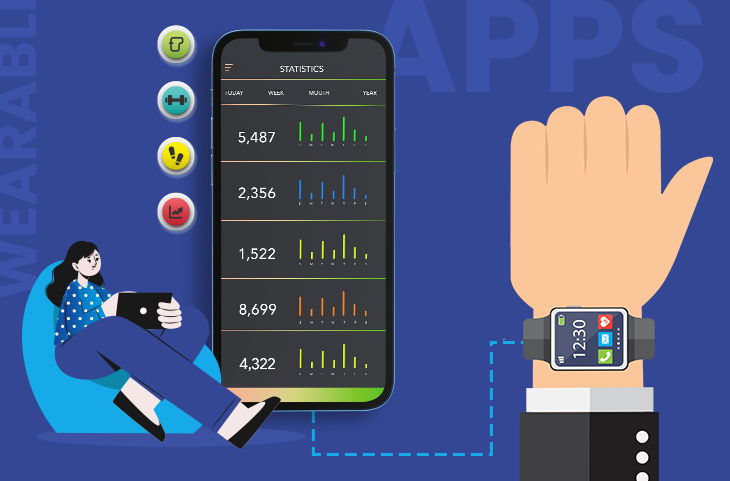In the ever-evolving landscape of technology, wearable devices have emerged as a significant trend, promising to revolutionize the way we interact with technology in our daily lives. From smartwatches and fitness trackers to augmented reality glasses, wearables have gained immense popularity, offering users convenience, accessibility, and personalized experiences. At the heart of these devices lie wearable apps, driving their functionality and unlocking a world of possibilities. In this comprehensive guide, we delve into the realm of wearable app development, exploring its significance, challenges, and future prospects.
Understanding Wearable Technology: Wearable technology refers to electronic devices that can be worn on the body, typically incorporating sensors and connectivity features to gather data and perform various tasks. These devices come in diverse forms, including smartwatches, fitness bands, smart glasses, and even smart clothing. With advancements in miniaturization, battery life, and connectivity, wearables have become increasingly sophisticated, offering a wide range of functionalities to users.
The Role of Wearable Apps: While the hardware components of wearables are crucial, it is the software, particularly wearable apps, that brings them to life. Wearable apps are designed to run on wearable devices, enabling users to access features, receive notifications, track health metrics, and interact with the device seamlessly. These apps leverage the sensors and capabilities of the wearable device to deliver a personalized and immersive user experience.
Key Features of Wearable Apps:
- Seamless Integration: Wearable apps should seamlessly integrate with the wearable device’s operating system and user interface, ensuring a smooth and intuitive user experience.
- Real-time Data Monitoring: Many wearable apps are designed to monitor real-time health metrics such as heart rate, steps taken, calories burned, and sleep patterns, providing users with valuable insights into their wellness.
- Notifications and Alerts: Wearable apps can deliver notifications and alerts directly to the user’s wrist, allowing them to stay informed about important events, messages, calls, and app updates.
- Gesture and Voice Control: With the limited screen real estate on wearable devices, gesture and voice control features enable users to interact with apps using intuitive gestures or voice commands, enhancing usability.
- Personalization: Wearable apps should offer customization options, allowing users to tailor their experience based on their preferences, fitness goals, and lifestyle.
Challenges in Wearable App Development:
Despite the potential benefits, wearable app development presents several challenges that developers must overcome:
- Limited Screen Size: Wearable devices have smaller screens compared to smartphones and tablets, posing challenges in designing user interfaces that are both functional and visually appealing.
- Battery Life Optimization: Given the limited battery life of wearable devices, developers must optimize their apps to minimize power consumption and maximize battery efficiency.
- Sensor Integration: Wearable apps often rely on various sensors to gather data, such as accelerometers, gyroscopes, and heart rate monitors. Integrating these sensors and ensuring accurate data collection can be complex.
- Connectivity Issues: Wearable devices rely on Bluetooth or Wi-Fi connectivity to communicate with smartphones and other devices. Developers must ensure seamless connectivity and address connectivity issues that may arise.
- Security and Privacy: As with any connected device, security and privacy are paramount in wearable app development company. Developers must implement robust security measures to protect user data and privacy.
Future Trends in Wearable App Development:
Looking ahead, wearable technology and wearable app development are poised for continued growth and innovation. Some key trends to watch out for include:
- Health and Wellness: Wearable apps will continue to focus on health and wellness, leveraging advanced sensors and machine learning algorithms to provide personalized health insights and recommendations.
- Augmented Reality (AR) and Virtual Reality (VR): Wearable devices such as smart glasses will increasingly incorporate AR and VR technologies, offering immersive experiences for gaming, entertainment, and productivity.
- Smart Clothing: The integration of sensors and electronics into clothing and accessories will give rise to smart clothing, enabling real-time health monitoring, posture correction, and biometric authentication.
- Voice Assistants: Voice-controlled wearable apps powered by AI-powered voice assistants will become more prevalent, allowing users to perform tasks and access information hands-free.
- Remote Work and Collaboration: Wearable devices equipped with communication and collaboration features will cater to the growing trend of remote work, offering seamless connectivity and productivity tools on the go.
Conclusion: As wearable technology continues to evolve, wearable app development will play a pivotal role in shaping the future of personal computing and human-machine interaction. By embracing the unique capabilities of wearable devices and addressing the challenges inherent in their development, developers can create innovative and impactful wearable apps that enhance the lives of users around the world. With a focus on usability, personalization, and cutting-edge technologies, the future of wearable app development holds immense promise for transforming the way we live, work, and play.


